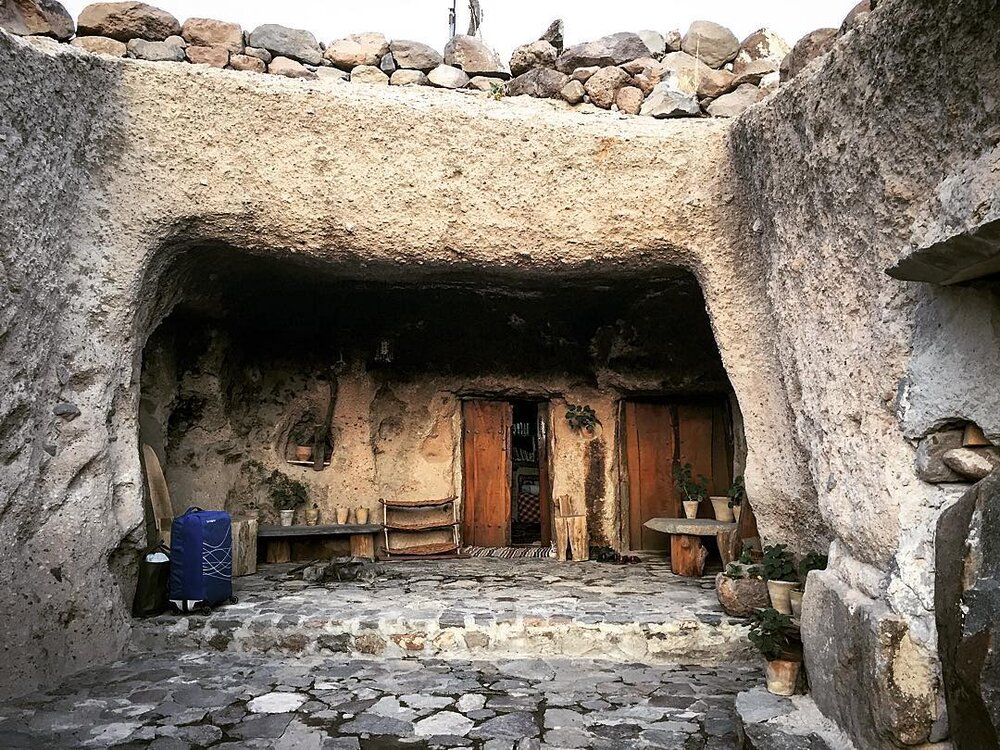Maymand: A very old village of troglodytes

TEHRAN - The term “cave dwellers” conjures up prehistoric images in your mind when caves served as one of the earliest dwellings for human beings. Here we want to take a look at Maymand, an exemplar manmade-cave dwelling in southeast Iran, where people made a living about five or six millennia ago.
The cultural landscape of Maymand was named a UNESCO World Heritage in 2015 as an exemplar system of manmade cave dwelling that is believed to be practiced in the region to cope with its harsh climate.
Maymand is situated near Shahr-e Babak in the southeastern Kerman Province. Its self-contained, semi-arid area is sprawled at the end of a south-facing valley at the southern extremity of Iran’s central mountains.
Sandwiched between a desert and a mountain, Maymand has cold winters and exceedingly hot summers yet abundant with mulberry and blackberry trees. Living conditions in the village are considered as severe due to the aridity of the land, high temperature in the summertime and very cold winters.
It is believed to be one of human’s primary residences in the country as its history stretches far back in time to about 10,000 years ago. Some of its natural and manmade caves are still used for housing and shelter.
The houses in the continually inhabited village are carved like caverns inside the mountain. The internal spaces have corridors and pillars featuring a rural architecture. The houses are situated in four or five stories, one on top of the other.

A view of rock-hewn houses in Maymand
Narratives say the early residents did not use hammer and chisel, but rather a type of local, pointed stone which was hard enough to carve images onto the rocks. This method of carving is still practiced in the region. Some of the stone engravings in the village date back to 10,000 years ago.
Narratives say the early residents did not use hammer and chisel, but rather a type of local, pointed stone which was hard enough to carve images onto the rocks. This method of carving is still practiced in the region. Some of stone engravings in the village date back to 10,000 years ago.The majority of inhabitants are semi-nomadic shepherds. They raise their animals on mountain pastures, living in temporary settlements in spring and autumn.
The community has a strong bond with the natural environment that is expressed in social practices, cultural ceremonies, and religious beliefs.
The local dialect contains words from the ancient Sassanid and Pahlavi languages. The dialect has been barely changed due to the remoteness of the village.
The area is also home to various animals such as snakes, lizards, hedgehogs, deer, leopards, wolves, foxes and also birds of prey.
There are few seasonal springs around the village that contribute to the flourishing of agriculture in the area. In such an arid climate, residents have to collect every drop of water to make a living as their ancestors did.
Under tourists’ eyes
Here is a select of comments that visitors to the prehistorical village have posted to TripAdvisor, one of the most popular travel websites in the world:
“Interesting”
If it’s your first time visiting a cave village, then you can’t but be impressed. Walking around, meeting locals, tasting their food or simply assisting their prayers it’s an authentic experience. Life here stopped years ago and sleeping in one of those cave houses is a must-to-do experience. You can trek around, find a family that shares dinner with you, and one of the tour best sleeps on a rocky bed. Recommend! (Andrea Lehotska from Milan, Italy; Date of experience: June 2019)
“Worth to visit and stay 1-2 night”
I visit when on the way from Yazd to Persepolis, this place is one of the interesting places on my trip in Iran, we stay there for 1 night and i really hope can back there and stay 1-2 weeks to discover more about local residence/ enjoy atmosphere, there a cave about 10km from village with old painting on rocks from ancients, hearing this cave-house is a kind of copy from the big cave. (Huynh W from Ho Chi Minh City, Vietnam; Date of experience: February 2018)
“Unique cave guest house”
A good and rare chance to experience a night stay in the ancient rocky cave guest house. It’s cooling during the day but cold at night. Fortunately, it’s equipped with a heater.
The village lady caters a meal to stay-in guests, but the food is very basic.
Remind to pack dry food as not to starve the whole night. Otherwise, one can make it a day trip and put up in Kerman hotel that is about 1.5 hour driver from Meymand. (Limleeaik from Kuala Lumpur, Malaysia; Date of experience: April 2017)
“A memorable experience”
I was amongst those in our group, who insisted on spending a night in this very very old village of troglodytes, in Meymand. It was indeed a memorable experience sleeping the night in the cave, the walls of which are completely black from the fire the locals used to lit near the entrance of the cave, to keep the interior warm. The dinning room-kitchen is about 150 meters away from the caves and so are the toilets and showers. It was cold, so walking in the cold after taking a shower was not very appealing.
On top of this and to make things worse, when the night fell we were alarmed by the jackals that were howling nearby. We heard them again just when we were ready to go to sleep, so our good driver went out with the car and made a round, just to make sure we were safe. And we were apparently, the night was good, it was warm and we had a lot of fun. The food was simple but delicious. It was well worth the experience! (Rhodes Maria from Heraklion, Greece; Date of experience: January 2017)
AFM/MG
Leave a Comment